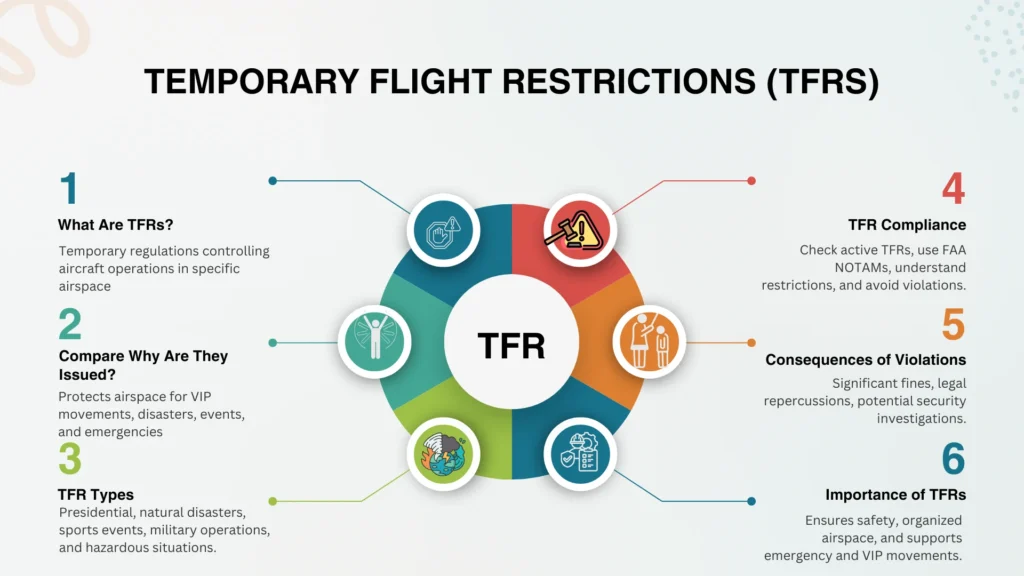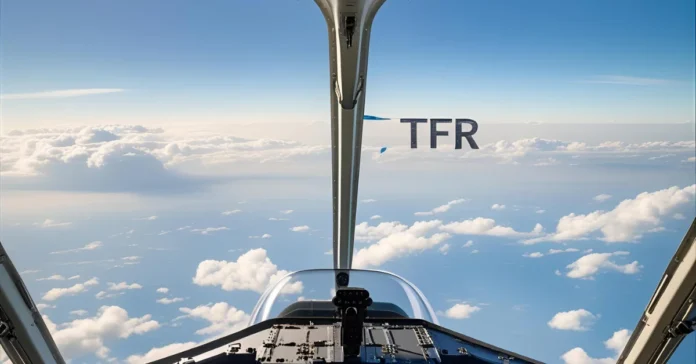Temporary Flight Restrictions (TFRs) are important regulations that control where and when aircraft can fly.
Introduced to keep airspace safe and secure, TFRs affect a wide range of situations—from protecting the President during his travels to managing airspace during natural disasters.
Understanding Temporary Flight Restrictions is essential for pilots and the general public alike, as they play a crucial role in maintaining safety in the skies.
Overview of TFRs
A Temporary Flight Restriction (TFR) is a directive issued by the Federal Aviation Administration (FAA) that limits aircraft operations in specific airspace for a limited time.
TFRs can be declared for various reasons, such as security needs, significant events, or emergencies.
When a TFR is in effect, pilots must change their planned routes or schedules to avoid the restricted area. This helps ensure the safety of both the aircraft and those on the ground.
TFRs are an essential component of airspace management, ensuring that events or emergencies can be handled without the complication of unnecessary air traffic.
By limiting flight operations in certain areas during specific times, TFRs can help prevent accidents and maintain order in busy airspaces.
Why TFRs Are Issued
TFRs can be issued for several reasons, including:
- Presidential or VIP Movements: When the President or other high-profile individuals travel, TFRs are put in place to protect them and ensure their safe travel.
- Natural Disaster Response: In the event of natural disasters like hurricanes or wildfires, TFRs help secure airspace to support rescue operations and ensure that emergency services can operate without interference.
- Major Sporting Events or Public Gatherings: Events such as the Super Bowl or large parades often trigger TFRs to manage air traffic and maintain safety for attendees and participants.
- Military Operations or Airshows: When the military is conducting operations or when special aerial shows occur, TFRs help keep civilian air traffic clear of these activities.
- Hazardous Situations: Situations like chemical spills or accidents can also lead to TFRs. These restrictions protect the safety of those in the air and on the ground by preventing aircraft from entering potentially dangerous areas.

How Pilots Should Comply with TFRs
For pilots, compliance with TFRs is crucial for safety and legal reasons. Here’s how pilots should ensure they are following TFRs:
- Check for Active TFRs: Before every flight, pilots must verify whether there are any active TFRs. This is a critical step that helps avoid unintentional violations.
- Use Official FAA NOTAM Sources: Pilots should access the FAA’s Notices to Airmen (NOTAMs) or use electronic flight bags (EFBs) like ForeFlight to obtain the most accurate and up-to-date TFR information.
- Review Altitude Limits and Time Windows: Pilots must understand the specific restrictions, including altitude limits, the radius of the restricted area, and the time frame during which the TFR is in effect.
- Avoid Restricted Zones: It’s essential to stay outside the restricted zones unless a pilot has obtained explicit clearance from the FAA. Violating a TFR can lead to serious consequences, including fines and potential legal action.

Example of a TFR in Action
A notable example of a TFR occurred during the Super Bowl held in 2025.
The FAA imposed a 30-nautical mile (NM) TFR around the event, which included a core no-fly zone of 10 NM for drones and general aviation (GA) aircraft.
This restriction was crucial for ensuring the safety of attendees and securing the aerial space over the stadium where the game took place.
Pilots who violated this TFR faced significant fines and could be subjected to security investigations for further review.
Quote
“TFRs are about more than convenience—they’re critical safety buffers,” says an FAA airspace manager. This highlights the importance of these restrictions in maintaining safety and security in the airspace.
Conclusion
Temporary Flight Restrictions (TFRs) are an essential tool for ensuring the safety and security of air traffic.
They are issued for various reasons, including the movement of important individuals, response to natural disasters, and the management of large events or emergencies.
Pilots must adhere to TFRs diligently to avoid severe penalties and maintain safety in the skies.
Understanding TFRs is vital not only for pilots but also for anyone interested in aviation and air travel. By recognizing the importance of these restrictions, the public can appreciate the complexities of managing airspace and the efforts made to keep everyone safe.
As air traffic continues to increase and events around the world draw large crowds, TFRs will likely become an even more critical aspect of aviation management and public safety.
Temporary Flight Restrictions: FAQs
- What is the purpose of a Temporary Flight Restrictions( TFR)?
Temporary Flight Restrictionsare implemented to ensure safety and security in specific airspace during events, emergencies, or noteworthy movements. - How can pilots find out if there is a TFR?
Pilots can check FAA NOTAMs or use electronic flight bags like ForeFlight for real-time updates on TFRs. - What happens if a pilot violates a TFR?
Violating a TFR can result in significant fines and possible legal repercussions, including investigations. - Are TFRs permanent?
No, TFRs are temporary and only remain in effect for the designated time specified by the FAA. - Can TFRs affect everyone flying?
Yes, TFRs can impact all types of aircraft, including commercial, private, and drone operations.
Recent Developments
In recent years, particularly after significant events like COVID-19, the FAA has adjusted its approach toTemporary Flight Restrictions to incorporate new safety guidelines.
With the rise of drone usage and increased public events, the management of airspace has become more crucial.
Newly proposed regulations aim to enhance communication about Temporary Flight Restrictions through more accessible platforms and real-time updates, reflecting the evolving landscape of air traffic management.
Sources:
Also Read:

